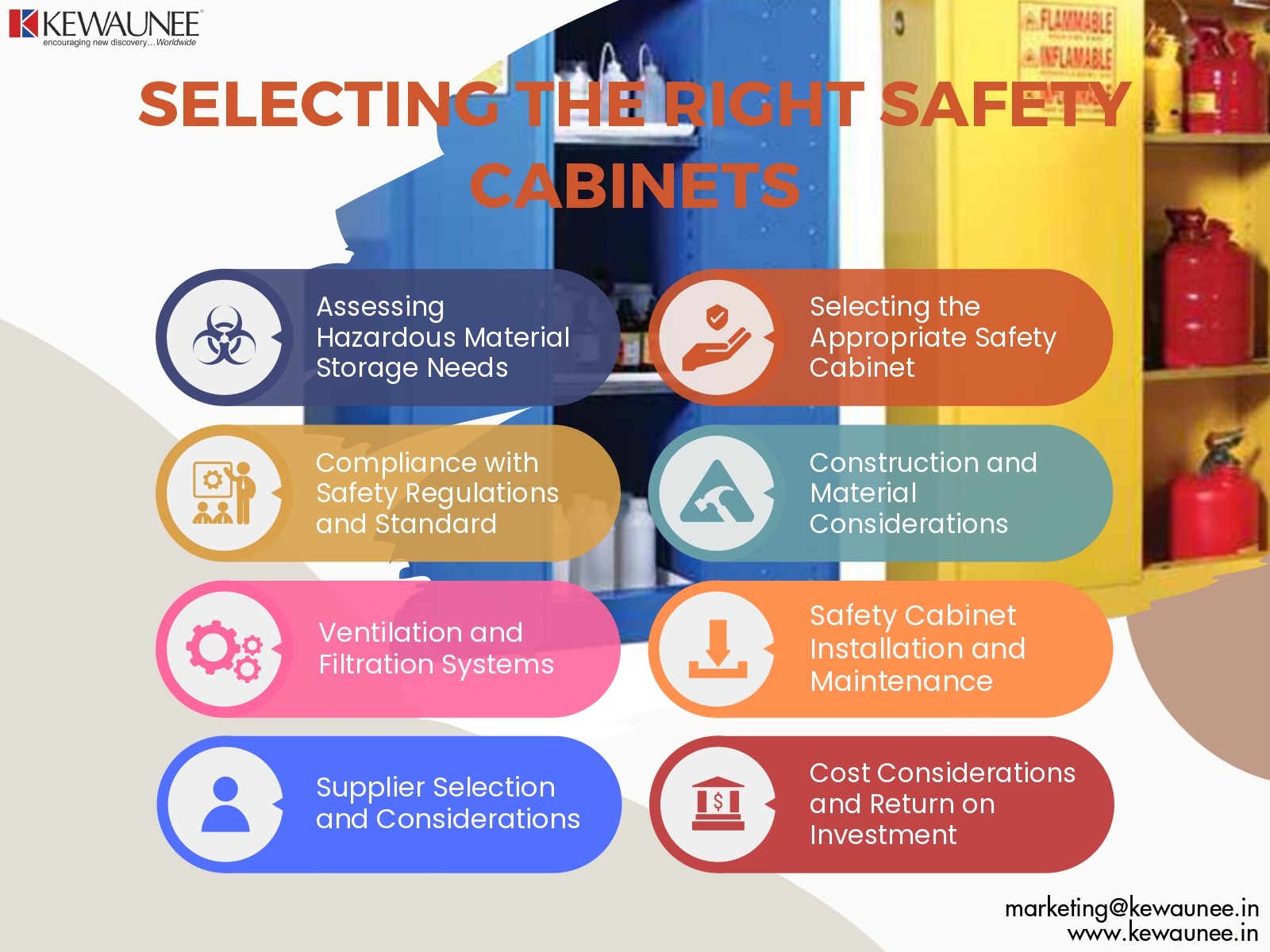A Comprehensive Guide to Selecting the Right Safety Cabinets
I. Introduction
Laboratory safety is of paramount importance to protect researchers, workers, and the environment from potential hazards. Safety cabinets play a crucial role in maintaining a safe working environment by providing secure storage for hazardous materials.
Safety cabinets are designed to store and handle various hazardous materials, such as flammable liquids, chemicals, and biological substances. They provide containment, ventilation, and protection against fires, spills, and exposure to harmful substances.
To ensure maximum safety and compliance in the laboratory, it is essential to choose the appropriate safety cabinets. This comprehensive guide will walk you through the factors to consider when selecting safety cabinets for different types of hazardous materials.
II. Understanding Safety Cabinets
A. Definition and purpose of safety cabinets
Safety cabinets are specialized storage units designed to mitigate risks associated with hazardous materials. They provide a controlled environment to minimize the potential for fires, explosions, and exposure to harmful substances.
B. Importance of regulatory compliance and standards
Compliance with safety regulations and standards, such as those set by Occupational Safety and Health Administration (OSHA) and National Fire Protection Association (NFPA), is vital to ensure the effectiveness and reliability of safety cabinets.
C. Different types of safety cabinets and their applications
Safety cabinets come in various types, including flammable liquids cabinets, chemical storage cabinets, and biological safety cabinets. Each type is designed to meet specific requirements for the safe storage and handling of different hazardous materials.
III. Assessing Hazardous Material Storage Needs
A. Identifying types and quantities of hazardous materials
Thoroughly evaluate the types and quantities of hazardous materials present in your laboratory. This assessment will help determine the appropriate safety cabinet types and capacities required.
B. Understanding storage requirements and compatibility
Different hazardous materials have unique storage requirements, including temperature, ventilation, and segregation considerations. Ensure compatibility between the material and the safety cabinet to prevent chemical reactions and accidents.
C. Conducting a risk assessment for storage hazards
Perform a comprehensive risk assessment to identify potential hazards associated with the storage of hazardous materials. Consider factors such as flammability, toxicity, reactivity, and corrosiveness to make informed decisions about safety cabinet selection.
IV. Selecting the Appropriate Safety Cabinet
A. Determining the appropriate cabinet type based on material characteristics
- Flammable liquids cabinets
Select cabinets specifically designed to store flammable liquids, providing features like self-closing doors, grounding mechanisms, and ventilation systems to prevent ignition and contain spills.
- Chemical storage cabinets
Chemical storage cabinets are engineered to store corrosive substances safely. Look for cabinets with corrosion-resistant materials, appropriate shelving options, and adequate ventilation.
- Biological safety cabinets
For working with biological materials, such as pathogens or genetically modified organisms, choose biological safety cabinets that provide a sterile and contained environment, protecting both the operator and the samples.
B. Considering storage capacity and space constraints
Assess the required storage capacity based on the volume and types of hazardous materials in your laboratory. Consider space limitations to ensure the selected safety cabinets fit seamlessly within the workspace.
C. Evaluating additional features and accessories
Depending on specific needs, consider additional features such as adjustable shelves, spill containment trays, locking mechanisms, and alarm systems. These features can enhance convenience, organization, and overall safety.
V. Compliance with Safety Regulations and Standards
A. Understanding relevant safety regulations and standards
Familiarize yourself with safety regulations and standards applicable to your laboratory, such as OSHA, NFPA, and any local or industry-specific requirements. Compliance ensures adherence to best practices and legal obligations.
B. Ensuring compliance with OSHA, NFPA, and other regulatory bodies
Verify that the selected safety cabinets meet the regulatory standards by checking for appropriate certification labels, compliance documentation, and adherence to specific guidelines outlined by regulatory bodies.
C. Certification and testing requirements for safety cabinets
Ensure that the safety cabinets you choose are certified and tested by recognized organizations. Look for certifications such as UL (Underwriters Laboratories) or FM (Factory Mutual) to guarantee their performance and reliability.
VI. Construction and Material Considerations
A. Exploring different cabinet construction materials (e.g., steel, polyethylene)
Safety cabinets are constructed using various materials, including steel, polyethylene, or a combination of both. Evaluate the material properties in terms of strength, durability, chemical resistance, and compatibility with the stored hazardous materials.
B. Evaluating fire resistance and containment properties
Consider the fire resistance rating of the safety cabinets to ensure they can withstand potential fire incidents. Additionally, evaluate their containment properties to minimize the spread of hazardous materials in case of spills or leaks.
C. Considering chemical resistance and durability
Different hazardous materials have varying levels of corrosiveness. Select safety cabinets with materials that are chemically resistant to the stored substances to prevent degradation or structural failures.
VII. Ventilation and Filtration Systems
A. Importance of proper ventilation in safety cabinets
Proper ventilation is crucial to prevent the buildup of hazardous vapors, maintain air quality, and ensure the safety of personnel. Safety cabinets should have effective ventilation systems that meet the requirements of the stored materials.
B. Understanding different ventilation options (e.g., ducted, filtered)
Evaluate the available ventilation options based on the specific requirements of your laboratory. Ducted ventilation systems expel hazardous vapors outside the building, while filtered systems use various filters to remove contaminants before recirculating the air.
C. Exploring filtration systems and their efficiency
For cabinets that utilize filtered ventilation, understand the types of filters used and their efficiency in capturing hazardous substances. High-quality filters are crucial to maintaining a safe working environment.
VIII. Safety Cabinet Installation and Maintenance
A. Proper installation and positioning of safety cabinets
Follow the manufacturer’s guidelines for the correct installation and placement of safety cabinets. Ensure cabinets are positioned in well-ventilated areas away from ignition sources and other incompatible materials.
B. Regular maintenance and inspection routines
Establish regular maintenance and inspection routines to ensure the ongoing functionality and integrity of safety cabinets. Regularly inspect seals, hinges, ventilation systems, and any other critical components.
C. Training staff on cabinet usage and safety protocols
Provide comprehensive training to laboratory personnel on the proper usage of safety cabinets and adherence to safety protocols. Educate them about the risks associated with hazardous materials and the importance of using safety cabinets correctly.
IX. Supplier Selection and Considerations
A. Evaluating reputable safety cabinet suppliers
Research and evaluate reputable suppliers who specialize in laboratory safety cabinets. Look for suppliers with a proven track record, positive customer reviews, and expertise in providing reliable safety solutions.
B. Considering factors such as warranty, customer support, and service availability
Consider additional factors such as warranty coverage, customer support, and the availability of spare parts or accessories. A reliable supplier should provide excellent customer service and be responsive to any queries or concerns.
C. Gathering product information and requesting quotes
Request detailed product information from suppliers to ensure the safety cabinets meet your specific requirements. Compare multiple quotes to make an informed decision while considering the overall value provided.
X. Cost Considerations and Return on Investment
A. Assessing the cost of safety cabinets and associated expenses
Evaluate the upfront cost of safety cabinets, including installation expenses. Additionally, consider the potential long-term savings resulting from improved safety, reduced accidents, and better protection of valuable laboratory assets.
B. Considering long-term benefits and cost savings
Take into account the long-term benefits of selecting the right safety cabinets. These may include reduced insurance premiums, minimized loss of valuable materials, and decreased downtime due to accidents or equipment damage.
C. Calculating the return on investment for safety cabinet selection
Calculate the return on investment (ROI) by comparing the cost of safety cabinets with the potential savings and benefits they offer. A well-designed safety cabinet that meets your laboratory’s needs will provide a higher ROI through improved safety and efficiency.
XI. Conclusion
In this comprehensive guide, we explored the importance of safety cabinets in laboratory safety and discussed various factors to consider when selecting the right safety cabinets for hazardous material storage.
Selecting the appropriate safety cabinets is crucial for maintaining a safe laboratory environment and protecting personnel, materials, and the environment from potential hazards. Here are the key takeaways:
- Understand the types and quantities of hazardous materials to identify the appropriate safety cabinet types and capacities needed.
- Ensure compliance with relevant safety regulations and standards, including certifications and testing requirements.
- Consider construction materials, fire resistance, containment properties, chemical resistance, and durability when evaluating safety cabinets.
- Evaluate ventilation and filtration systems based on the specific requirements of your laboratory.
- Proper installation, maintenance, and staff training are essential for the effective use of safety cabinets.
- Select reputable suppliers who provide excellent customer support and consider factors like warranty coverage and service availability.
- Assess the cost of safety cabinets and associated expenses while considering the long-term benefits and ROI.
By following these considerations and selecting the right safety cabinets, you can significantly enhance laboratory safety, mitigate risks, and ensure compliance with applicable regulations. Prioritizing the safety of personnel and the integrity of hazardous materials storage will contribute to a productive and secure laboratory environment.
Comments are closed.











